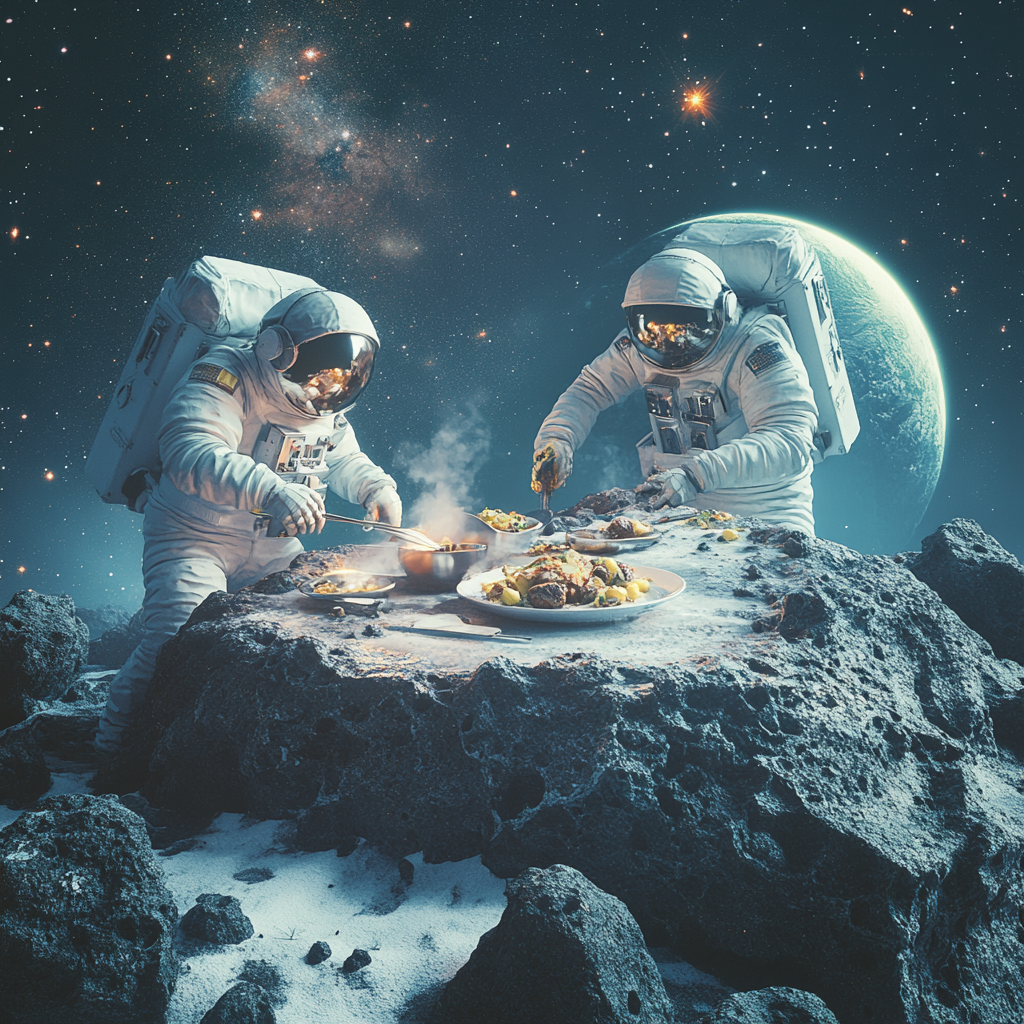
Cosmic Harvest: Asteroids as Future Space Pantries
Asteroid Dining: The Cosmic Food Source for Future Space Explorers
Imagine this: you’re floating weightlessly in a sleek spacecraft, gliding past the vibrant rings of Saturn and between the craters of moons where no human has tread. The glittering stars outside compete for your attention, but you’re not just marveling at the vastness of space. No, you’ve got your eye on something much more delectable and futuristic—your meal, sourced from asteroids! That’s right, scientists are shooting for the stars and, quite literally, aiming to transform asteroids into the ultimate cosmic buffet for astronauts.
Now, don’t roll your eyes just yet; this isn’t merely sci-fi mumbo jumbo. This audacious idea is being brewed up by a team of intrepid researchers over at Western University’s Institute for Earth and Space Exploration, and it's piquing both curiosity and appetite. Let’s dig into the cosmic soil of this concept and explore how it could change the way we fuel our adventures in the great beyond.
The Culinary Space Challenge
Before we start dreaming of gourmet asteroid dinners, let’s face the facts about how astronauts currently survive on their interstellar escapades. Right now, it’s all about those resupply missions from Earth—elaborate, expensive, and highly logistical gambits that, let’s be honest, don’t hold a candle to the idea of self-sustaining food systems on-site. Picture having to wait weeks for a burger delivery—frustrating, right?
As we shoot for more distant stars, like Mars and beyond, the equation changes dramatically. We've got to find a sustainable and practical way to deliver meals without relying on planet Earth’s pantry. And what better way to do this than to snag a few ingredients from our cosmic neighbors?
The Asteroid Farmers: New Age Space Cowboys
Enter the realm of asteroid farming, a novel concept with the potential to truly redefine space dining. The plan? Tap into the rich organic matter lurking within carbonaceous chondrites—yes, that’s a fancy way of saying certain types of asteroids that are brimming with the good stuff, like carbon and water. Think of Bennu, an asteroid NASA's OSIRIS-REx mission gallantly explored back in 2018. This celestial rock might not only hold clues about the early solar system but could also be the next hot spot for gourmet space cuisine.
So, how exactly will this cosmic cavalcade come together? The magic lies in a process called pyrolysis. Yes, it sounds complex and a bit space-age, but the gist of it is rather simple. Under high heat and without any pesky oxygen involved, outdoor campfire vibes come into play. The organic materials are broken down into hydrocarbons (not the oil kind, mind you). These hydrocarbons can then be consumed by specially bred microbes that have developed quite the refined palate. And voilà, these tiny powerhouses convert those hydrocarbons into the good stuff—a kind of nutritious sludge reminiscent of everything from caramel milkshakes to yogurt. Delicious, right?
Numbers Game: Yielding Astounding Numbers
Let’s break this down with the sweet sauce of numbers. When you do the math, pulling from an asteroid like Bennu could yield anywhere between 50 to 6,550 metric tons of edible biomass. Depending on how efficient our microbial chefs turn those hydrocarbons into breakfast cereals or protein shakes, we’re talking about sustaining anywhere from 600 to an impressive 17,000 astronaut life years with the morsels of one asteroid. That’s like going to cosmic Costco!
Cooking Up Challenges Ahead
But before we start throwing asteroid-feast parties, there are hurdles that need to be jumped over like space bunnies on a trampoline. Safety is paramount—after all, we don’t want to be feasting on something that’ll make our astronauts’ stomachs flip upside down. Rigorously evaluating the safety and toxicity levels of the biomass is non-negotiable.
Establishing mining operations in space is another monumental task. Seriously, transforming a spacecraft into a working kitchen, complete with mini-bacterial farms, may well become the next frontier of engineering magic. And let’s not forget that asteroids, in all their rocky glory, don’t have standard compositions. Each one is a wild card in the cosmic kitchen, which could complicate menu planning considerably.
Testing the Waters, or Should We Say, Meteorites?
Before we bite into asteroid tapas, researchers are putting their theories to the test on more terrestrial materials. They started with meteorite samples that have graced our planet; these space rocks make for fascinating gastronomical guinea pigs. Bacteria have been happily munching on the carbon extracted from these meteorites, proving that our microbial friends can thrive in the cosmos’ buffet.
The researchers aren’t stopping at meteorites. They’re experimenting with other carbon-rich materials, like coal and even old plastics, turning trash into gourmet treasures. Partnering with DARPA, they’re exploring how military waste can be transformed into useful resources—it’s kind of like turning lead into gold but for sustainable space food!
A Deliciously Promising Future
The idea of mining asteroids for meals is no longer locked away in the archives of science fiction. With each passing day, the possibilities become a tantalizing reality, promising to reshape how we envision long-haul space missions. If Joshua Pearce from Western University is to be believed, there’s a natural harmony between bacteria and asteroids that could change our culinary narrative. “When you look at the pyrolysis breakdown products that we know that bacteria can eat, and then what’s in asteroids, it matches up pretty reasonably, actually. So I think this can actually work,” he posits, and who are we to disagree?
As we gaze to the stars, the notion of asteroid harvesting for sustenance transforms from the absurd to the attainable. The cosmos isn’t just a playground for explorers; it's a pantry waiting to be opened.
Call to Action
Want to stay up to date with the latest news on innovative space technologies and potential breakthroughs like asteroid farming? Subscribe to our Telegram channel: @channel_neirotoken
Remember, the universe has vast potential, and as we carve out a path to the stars, understanding how to nourish our bodies is just as crucial as the voyages themselves. Bon Appétit in zero gravity!
